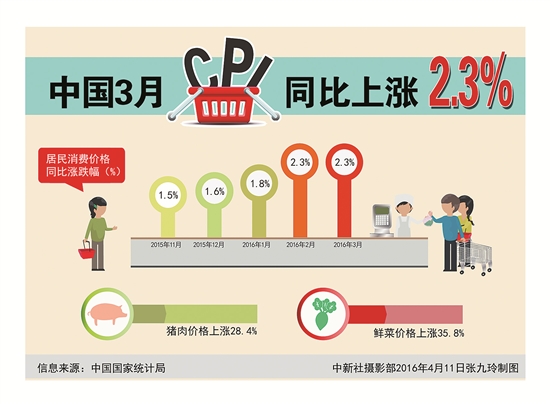China's consumer prices grew 2.3% in March from one year earlier, the same as in February, according to data released by the National Bureau of Statistics Monday. The consumer price index (CPI) shrank 0.4% in March from February.
国家统计局周一发布的数据显示,3月份全国居民消费价格指数(CPI)同比上涨2.3%,涨幅与二月相同,环比下降0.4%。
NBS statistician Yu Qiumei attributed the inflation growth mostly to high vegetable and pork prices.
国家统计局统计师余秋梅将此归因于通货膨胀的增长,主要是蔬菜和猪肉的价格升高。
Pork prices jumped sharply by 28.4 percent year on year, contributing 0.64 percentage points of CPI growth, while vegetable prices skyrocketed by 35.8 percent, accounting for 0.92 percentage points of CPI growth.
其中,猪肉价格同比大涨28.4%,影响CPI上涨0.64个百分点。鲜菜价格飙涨35.8%,影响CPI上涨0.92个百分点。

Food prices soared 7.6 percent year on year while non-food inflation edged up 1 percent in March.
在三月份,食品价格同比上涨7.6%,而非食品价格上涨1%。
Since January, CPI data have been calculated using a new comparison base that takes into account new products and services, reflecting a change in consumption patterns. The adjustment slightly reduced the weight of food, which previously accounted for nearly one-third of the CPI calculation.
自今年一月以来,全国居民消费价格指数的已经开始使用一个新的比较机制来进行计算,该机制将新的产品和服务考虑进去,反映了消费模式的变化。这一调整将食品所占的比重略微降低,此前食品比重接近占到了总CPI的1/3.
The producer price index (PPI), a measure of costs for goods at the factory gate, dropped 4.3 percent year on year in March, narrowing from a 4.9-percent drop in February and 5.3-percent decline in January, according to the National Bureau of Statistics (NBS).
据国家统计局报告显示,衡量工业企业产品出厂价格的生产价格指数,在三月份同比下降4.3%,降幅比二月份的4.9%和1月份的5.3%有所缩小。












